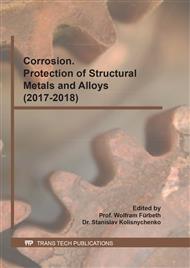p.1639
p.1645
p.1651
p.1656
p.1662
p.1668
p.1674
p.1680
p.1686
Superhydrophobic and Corrosion Protective Coating on Aluminium
Abstract:
Industrial application of superhydrophobic surfaces is limited by the unsatisfactory mechanical properties of the material. Combining chemical etching and anodization terraced features containing aluminium oxide on different aluminium alloy surfaces were produced. After modified by fatty acid, the surfaces were superhydrophobic and they showed self-cleaning effect. The highest contact angle was obtained after forming hierarchical structures with a solution free of fluorine compounds; therefore, the process is considered eco-friendly. The alumina formed in the coating process promotes an improved corrosion resistance. The present study has three main objectives: to identify the molecules responsible for superhydrophobicity, the mechanism by which superhydrophobicity is produced, and consequently the influence of variables such as anodization time on the proposed processing method. We use time-of-flight secondary ion mass spectrometry (TOF-SIMS) and X-ray photoelectron spectroscopy (XPS) techniques to identify each compound involved in the final surface, by paying close attention to the analysis of the mechanism by which the chemical reaction proceeds. The morphology of the superhydrophobic surfaces was further observed by scanning electron microscope (SEM) and atomic force microscopy and was used to elucidate the effect of the anodization time in the properties of the superhydrophobic material.
Info:
Periodical:
Pages:
1662-1667
Citation:
Online since:
December 2018
Price:
Сopyright:
© 2018 Trans Tech Publications Ltd. All Rights Reserved
Share:
Citation:



